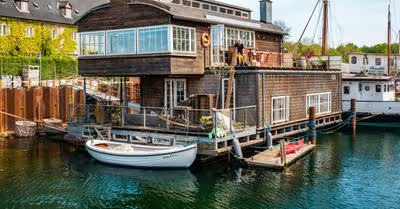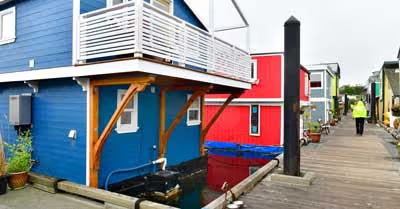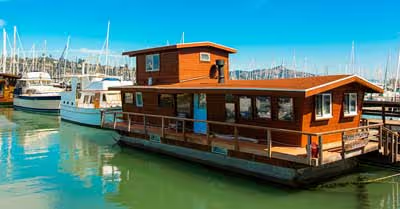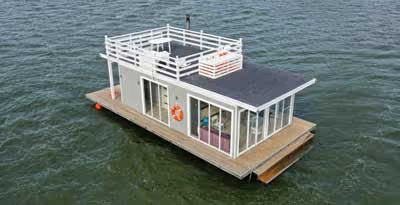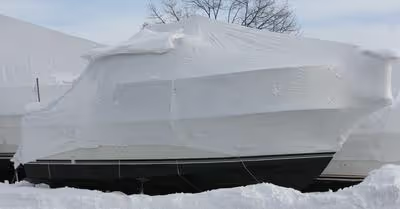
Preparing your houseboat engine for winter months? The cooler temperatures and shorter days are all signs of winter arriving and the boating season-ending.
Though this may sound depressing, this is still a challenging time because it means you’d have to work to winterize your boat and prepare the engine from freeze damage.
You could do this in a couple of ways, such as emptying carburetors and fuel lines, draining cooling passages, lubricating linkages and engine starter drive mechanisms, stabilizing the fuel, checking the battery, etc.
However, there’s more that goes into protecting your houseboat engines. Whether it’s the maintenance the task entails or protecting batteries from frost, there’s a lot you need to know and understand before winterizing your motors.
In this post, we discuss everything you need to know about winter-proofing your houseboat engine. We will talk about how to winterize houseboats engines, covering every aspect of protecting the overall boat system. Continue reading to know some useful tips and tricks for better maintenance.
Why is Winterizing Your Engines Important?
Before I get into how to winterize your houseboat engines, it’s worth understanding why the process is necessary in the first place.
Winterization is considered a way of safeguarding the numerous equipment and systems present on your houseboat from damage caused by freezing. It can help protect the most vital components of the boat, such as bottom units, engines, electric hookups, and batteries from frost damage and wear and tear.
Houseboat owners undertake winterization to prepare for the most extreme cold when the temperatures fall to the freezing point. For the most part, you can think of it as preparing your boat for hibernation. Though boat engines may be a bit more complex to manage, you are essentially just planning ahead for a period you cannot use your boat.
If you don’t winterize your engine, it’d cost you dearly for when you plan to start boating again in spring. You’d have to spend much more on the subsequent maintenance and repairs.
As a result, if you really want a deeper understanding of how to winterize your houseboat engines and why it is an absolute must-do, I recommend talking to a local professional or someone in your marina about it. Besides just the engine, the whole houseboat needs to be evaluated and maintained accordingly.
How to Winterize Your Houseboat Engine
Houseboat maintenance and winterization are no easy tasks. A lot goes into ensuring your safety and safeguarding any investments you’ve made to your floating home. We cover the various steps required in the winterization process in the following sections.
Changing the Oil
Oil changes are probably the most basic form of engine maintenance. They are done to eliminate any moisture and prevent the possibility of corrosion. Without oil changes, this moisture can result in loss of power, excessive wear, poor fuel economy, and possible engine failure.
You'd usually have to do this after summer and tough winters because moisture might accumulate again during this period. It doesn't really cost a lot either. At most, you can see yourself spending $30 to $75 on an oil change while saving yourself a potential $500 to $20,000 in frost damages later.
Coating with Anti-Corrosion Spray
As you prepare your houseboat for the coming season, it’s vital to not miss crucial anti-corrosion measures. I recommend the use of an anti-corrosion spray. They are usually mentioned in any guide about how to winterize houseboat engines. And they can work wonders on outboard and inboard components alike.
Removing Fuel Lines
Another crucial step to learning how to winterize your houseboat engines is to practice taking out the fuel tank and fuel lines. Though you can drain the pipes instead, you'd have an easier time removing them altogether.
So, if your engine ends up dying during the challenging winter months, you'd have empty delivery components to prevent gums or gunk from forming. These are usually caused by clogged jets, lines, injectors, or stagnant gasoline.
For this process, I recommend using a snowblower. If you cannot manage to empty the boat completely, you could also top it off at only 95%. This is particularly crucial since fuel with ethanol can experience phase separation through moisture. By filling the tank, you'd essentially be limiting the air space within the tank and restricting the potential of internal condensation.
Fogging the Engine Cylinders
Through aerosol fogging, you can coat the inside of your engine to protect it all the way to spring. Depending on your engine manufacturer, you could also have plenty of proprietary products considered ideal for your motor.
The steps to this include just hooking your engine with "ear muffs" and a garden hose. You can then start the engine and spray it directly with a fogging solution into the air intake. This would work as an anticorrosive measure, protecting the internal structures of your cylinders and carburetors.
You'd have to do this before the engine runs out of fuel. Moreover, if it ends up running rough before you run out of power, I recommend giving it a heavier dose of fogging oil, ensuring the internal surfaces are fully coated.
Treating Your Fuel
While learning how to winterize houseboat engines, another crucial step is to treat your boat's fuel through a stabilizer. This could involve using products such as PRI-G, Stabil, and Stabilizer.
You should add this to the fuel and run the engine for about 10 minutes to stabilize the fuel injectors and carburetors. If you don’t do that, it could result in these components clogging through varnish deposits, thus, ruining the fuel systems.
Draining Cooling Passages
Though this isn't as important as the other steps I have mentioned, it can help to disconnect your flush attachments or remove them from the flush tank before winter arrives. This can be done by keeping the motor upright and letting all the water drain out from the pick-up. You can empty intermediate housing schemes or powerheads by opening drain plays (if they're available on your houseboat model).
The spark plugs should be removed and sprayed with fogging oil. This should be done within the holes of the passages, coating the insides of the cylinders. Attempt to rotate the flywheel a few times, ensuring the oil spreads across all the walls.
Please note that when you remove the spark plugs, you should also try checking them before reinstallations in spring. If needed, you should replace or re-gap any plugs before reinstalling them.
Draining and Recycling the Gear-Case Lubricant
Last on this list of how to winterize houseboat engines is the use of clear and amber-colored lubricant. This would help guarantee that all gear-case seals are in good shape.
Typically, a sign of replacement would be the discharge of milky or sometimes lumpy oil. You should do this around a time near fall when marine mechanics would usually be less busy and offer special discounts for undertaking winter work. The maintenance costs are only about $10, saving you $2,000 to $6,000 in potential damages.
Is it Necessary to Fog Your Boat's Motor?
Fogging is a crucial aspect of knowing how to winterize your houseboat engine. Especially when considering long-term storage, fogging can be really beneficial to your outboard motor.
It essentially works as a waxy oil you spray onto your engine, coating it and its respective components in a protective layer against corrosion. But, for it to effectively work, you’d need to spray it carefully into your spark plugs and carburetors, ensuring that the oil coats each component properly.
The oil would then coat the motor with a film that’d remain while the engine is stored long-term.
The primary reason it’s considered necessary for winterizing your boat engine is for the rust-prevention benefits it brings. Unlike regular oil with water and impurities that can damage your engine, flogging protects your engine walls from components that could potentially damage it.
How Long Can Your Boat Engine Sit Without Running?
In practice, you can store a boat for a pretty long while. As long as it’s well-maintained before being taken into storage, there’s not a lot that can go wrong. You can expect your boat to be stored for several months. Or, you could even safeguard it for a lifetime when checked every once in a while.
In particular, the most important element affecting your engine is condensation. It can only really occur in years, sometimes even decades. So, a properly treated engine will never fail to work. However, you might need to invest in fuel treatment every 6 months.
Should You Keep Your Boat Off the Water?
Keeping your boat off the water is among the first steps to learning how to winterize houseboat engines. This choice can vary, depending on the type of houseboat you own.
For example, trailer boaters are straightforward as they can be brought and parked on land, and you'd never have to think about the problem of your houseboat freezing while staying in a frozen lake during long winters. Although, this becomes more complex with larger boats. In these cases, depending on the location where it is tethered, it may be difficult to haul out your entire boat. Instead, it may have to bear the rough winters while still docked on the water.
Each of these methods has its own costs, varying with the size and type of the boat in question. Some of the challenges you might expect from storing your boat on the water include:
- Need to winterize your holding tanks and freshwater systems
- Having to control any corrosion
- Prevent ice from forming around the boat
- Having a reliable source of heat if possible
Would You Need to Winterize a Docked Houseboat?
Though a docked houseboat may be simpler to handle, it doesn't mean that winterization is not needed. You'd have to winterize your boat when it's not used for extended periods. Whether in cold or warm regions, your wasted fuel is guaranteed to spoil without a stabilizer.
When dealing with extremely low temperatures, you might not need to put antifreeze in your water sewage pipes. Though this isn't all there is to know about how to winterize your houseboat, you’d still have to consider other problems your boat could experience.
For example, over time, your houseboat can be infested by rodents or bugs. These animals and insects breed and multiply according to the change in seasons, and they could end up moving into your boat by the dozens during summer. Though this doesn't result in any substantial damage to your houseboat engine, it can still add up to costly repairs and cleaning later.
Besides that, since pests are often minuscule, they can hide in places you wouldn't expect to look. You need to ensure that you're protected against these critters, such as bugs, mice, etc. This can be done by sealing any small spaces, such as gaps, holes, niches, etc. It would be best to replace any wool with stainless steel.
If these crevices are somewhat bigger, you should still try to adequately seal them. Just like in colder regions, water left on your deck during summer can also be a menace. This can result in numerous difficulties over time, including rot, standing water, and rust. You should be mindful that plenty of issues could arise when you dock houseboats. You just might need to prepare accordingly.
How Cold is Too Cold for Your Houseboat
Winter months are rough for houseboats. These periods can reach temperatures as low as -2 degrees Celsius, especially when dealing with unplugged engines.
As a result, you should know that unwinterized boat engines can freeze anytime they are left at temperatures below -5 degrees Celsius for extended periods. If they are unprepared for the cold, for example, when they have a freshwater cooled engine without an adequate coolant, you can expect them to freeze at even 0 degrees Celsius.
The Bottom Line
Although preparing your houseboat for the tough winters is an essential job, you should know that learning how to winterize your houseboat engines is a tiring process. If you really want to commit to this task, I recommend doing adequate research and looking into possible solutions well beforehand.
Try asking around and checking in with local technicians. Remember that there are no shortcuts to ensuring your houseboat’s wellbeing. Though this may all seem very labor-intensive, costly, and time-consuming, I promise you that the pay-off is worth it. I wish you good luck and happy boating!



